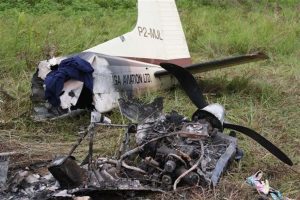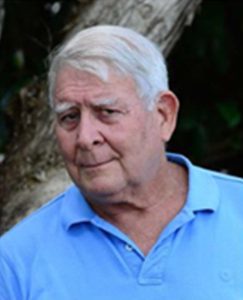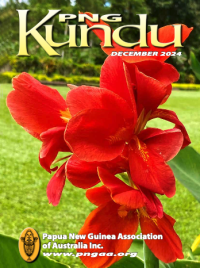The Saruwageds Revisited
Martin Kerr—Ex-Kiap 1964
Can I offer some clarification about the Saruwageds, and who crossed them and when? The role of New Guinea’s generation of ‘Europeans’ should not be dismissed as pure and destructive colonialism when, in fact, locals obtained many benefits and also, at times, expressed appreciation for their own positions, enhanced by contact with miners, oil searchers, missionaries, kiaps and the like.
What follows may be of interest to your readers. Some of your recent contributors emphasise their specialisations, academic qualifications and claim special relationships with locals through marriage and so on. Such contact inevitably results in quite normal extended family arrangements with inevitable ups and downs. Regardless of the sire, kiap, adventurer, plantation owner, plantation manager, priest or scientist, life goes on.
Mention is made of the previous groups who crossed, including Peter Ryan, followed by the retreat of Japanese forces in 1943 from Lae to Finschhafen.
This writer got the impression that Ian Howie-Willis, Robin King, Matt Linton and Hector Clark were the only outsiders since World War II who, in 1976, had crossed the almost impregnable barrier of the Saruwageds. Untrue. Peter Shanahan, who featured a number of times in Una Voce, and more recently in PNG Kundu, passed through in 1964 from Pindiu. He was a specimen collector on Dr J Linsley Gressitt’s expedition, representing the Bishop Museum, Hawaii, on behalf of the U.S. Department of Defense. Members of this party, Czechoslovakian refugee entomologist and teacher of biology Joe Sedlacek, and two Hungarian scientists, plus assistants and their equipment, required three brief flights from Finschhafen to Pindiu.
The patrol post was later serviced by Richard Leahy, who set up a trade store, who later crashed his plane in 2010 near Baindoang with the loss of all six passengers on board. Richard and Peter, both New Guinea-born, were friends and went crocodile shooting among the Orokaiva.
The specimen collecting group took five days to cross the Saruwageds, during which time Peter discovered numerous caves and suffered injuries collecting small bats and many other specimens. What Peter observed as arrogance from the scientists resulted in a standoff with their carriers, who refused to go further unless their pay was increased.
Recognised through the local grapevine that Peter was a grandson of the German Bruno Wilde and the son of gold miner and coffee grower, Tom Shanahan, he was able to establish a mutually acceptable bargaining position with the local headmen. The expeditioners continued on their way using a route identified by the carriers and finally descended to Sangawa copra and cocoa plantation.
After enjoying the usual overnight plantation hospitality, they travelled by road into Lae, crossing the Busu River in a quiet state at an established ford. After returning from the Solomon Islands in 1965, Peter waded the Busu at the mouth.
Peter was trained in specimen collecting by Joe Sedlacek and others, which included the use of mist nets, light traps, use of dangerous chemicals, including cyanide, as well as recording results in small print on labels for insects. A specimen collecting party was also armed with under and over shotguns for taking birds, possums, tree kangaroos, etc. All specimens collected had to be dissected and/or skinned, preserved and recorded in field manuals.
Peter and Richard visited Mount Lamington. With guns and collecting equipment, their party took a shortcut in a vehicle across a neatly laid lawn and discovered Bishop Philip Strong at Dogura in his bishop’s finery, entertaining Prince Charles and fellow Timber Top students to afternoon tea on the veranda of his glorious residence.
Besides socialising in Wau and Bulolo with others, including forestry officials, miners and kiaps, Richard Leahy travelled the mighty Sepik River leaving his aircraft at Ambunti. He accompanied this writer in September 1967 in a double trading canoe as far as the West Papua border, shooting crocodiles by night with his skilled staff from a punt with a 20 hp Mercury motor.
Richard was determined to achieve independence with his business ventures, being a son of Mick Leahy, who, with his brother Dan, opened up the Western Highlands on a controversially destructive gold prospecting expedition in 1933. I believe Richard holds a collection of coloured slides recording his work and travels through New Guinea.
As a matter of passing interest, this writer worked closely in Queensland during the early 1970s with a tall, impressive ex-serviceman of the Ninth Division who landed at the beach-head near Lae and suffered the setbacks of air raids, weather, disease and the crossing of the Busu at its mouth.
The purpose of this campaign is described in Phillip Bradley’s book, D-Day New Guinea (Allen & Unwin 2019), using heavy tank landing craft and paratroopers to destroy or capture enemy assets supported by air power. The paratroopers were ordered not to attack but to repair and strengthen Nadzab airstrip. An Australian Independent Company held their ground on a section of the Busu River. Eight thousand retreating Japanese forces bypassed them into the Saruwageds, losing 2,000 troops on the way to Finschhafen.
Peter Shanahan

The remains of Richard Leahy’s Kiunga Aviation Cessna 185 after the fatal crash, 2010 (photo by Bustin Anzu)
Peter and his mother, an American-Samoan compatriot of New Britain’s Queen Emma, were evacuated from New Guinea in 1942 while his father stayed on to fight the Japanese. Educated in Sydney’s private schools, Peter forgave further studies to expand his parents’ copra and cocoa plantation. Gaining experience in land surveying and plantation operations in Rabaul, he was recalled to manage Wau Coffee Estates.
Peter also became a fauna collector for the Bishop Museum, Honolulu and gained a degree in biology in the United States. He moved to Australia in 1981 and joined the Queensland Department of Forestry, taking a position in the inaugural team raised for the Great Barrier Reef Marine Park Authority. A former lecturer and interpretive officer for the Cairns Botanic Gardens, Peter was elected President of Friends of the Gardens. He enjoyed a menagerie of ‘friends’ at his rainforest retreat in Kuranda, Queensland.
This writer is the editor and amanuensis of Peter Shanahan’s manuscripts titled Jungle Shan: Growing up in New Guinea and The Birdman of Wau. His cousin Anthony Mayfield and his family hold these two volumes of unpublished memoirs. Peter visited this writer in Atherton with Anthony Mayfield and his wife Julia on 2 February 2020, before he passed on 13 March 2020. Through Shanahan family connections, a memorable day as children was spent with Peter and his sister Gail in Wellington in 1949.
Editor’s Note: Martin Kerr’s New Guinea Patrol was first published in 1973. His cult memoir, short stories and seven novels are available on Kindle, www.maskimedia.com or by email martindkerr@gmail.com



